The Mongolian Desert - Page 3
Clothing:
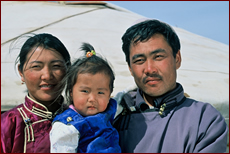
The traditional garment is the del, which is worn on special occasions as well as for everyday wear. It is worn by men and women, although the men’s are generally of more muted colours. It is a long, loose gown with a high collar which overlaps widely at the front and has a sash around the waist. Every ethnic group has their own distinctive style of del, with different colours, cut and decoration. Everyday dels are practical and dark coloured, those worn for holidays and celebrations might be bright blue, green or deep claret. In cold weather, a jacket called a Khurem is worn over the del. Mongolian men and women wear traditional hats, which are trimmed with fur. In the winter they have flaps which can be worn over the ears to keep them warm; in the summer these are tied back over the top. The hats are also symbolic, with the knot on top representing the unity of the nation, red ribbons being the sun’s rays, and the wide brim representing the country’s inaccessibility.
Community and Communications:
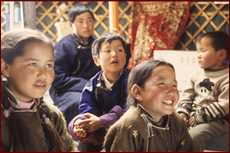
Mongolian people are generally regarded as very friendly and hospitable, perhaps due to their difficult lifestyle. If a guest or traveller arrives at their gher, a host will appreciate how tired they are from their long journey and do their utmost to make their stay comfortable. Traditions are upheld much more in the countryside than in the cities, where people behave much as they would in any international city. In more traditional families, it is important to greet and address people properly, according to their status and age.
Mongolian is an ancient language, belonging to the same group as Finnish, Turkish and Korean. In speech it uses the tongue, teeth, palate and lips to produce sounds. It has a wide vocabulary relating to Mongolian life, culture and customs which can be difficult to translate into other languages as the words are so specific. The traditional script has 5 vowels and 22 consonants, and is written vertically like Japanese. However it is not used with any regularity now - the Cyrillic script was adopted in 1941 and is now used universally.
Since gaining independence in the 1990s, there has been a huge expansion in methods of communication. Mongolia has an extraordinary 525 newspapers and a wide range of magazines, while the first private radio and television stations have been established. The large proportion of Mongolians that are under 30 years of age (60%) are generally more outward-looking than the older generation, and are bringing more and more Western influences into the country, through media, films and music.
Livestock:
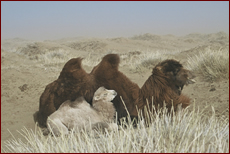
Mongolians who still live the traditional nomadic lifestyle make up around 40% of the population, and they tend around 25 million livestock. They practise pastoral nomadism, which means they move their homes and animals around the desert. This means that the environment can sustain many more people than it would under any other kind of farming. The desert environment of Mongolia is very harsh and it would be extremely difficult to grow enough crops to sustain a family every year, but by moving around the desert, the Mongolian nomads are able to make the most of the patchy and unpredictable weather and landscape. The main animals kept by the Mongolians are horses, camels, cattle, sheep and goats.
Camels:
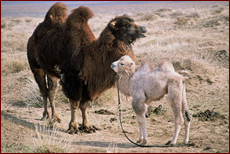
The camels in The Story of The Weeping Camel are Bactrian, which have the distinctive 2 humps. Bactrian camels also live in the wild in Mongolia, but are very close to extinction – the vast majority are now domesticated. It’s estimated that there are only 1,000 left in the wild, with the main threat to their lives from habitat loss. As more towns are built up in the Mongolian desert, less watering holes are available for the camels. They are also in competition with the domesticated herds.
Camels are extremely well suited to living in the desert; in the summer their coat is short and thin and in the winter it grows thick, long and dark which protects them from the cold. They can close their nostrils to keep out sand in high winds. Although their walk looks strange and swinging, they can outrun a horse – their top speed is 65 km/hr. They can be 3m tall and weigh up to 700kg. Camels eat mostly grass, leaves and shrubs, but they will eat thorns, dry vegetation and saltbush if they have no alternatives. Their humps are not full of water, as is commonly believed, but fatty tissue. This helps them to survive long periods where they may not be able to eat properly, and can also indicate if they are healthy – when they are properly fed their humps are plump and stand upright. If they are undernourished the hump can shrink and lean to one side.
Most camels give birth in March or April, after a gestation period of 12-14 months. The calves stay with their mothers for about 1.5 years and are not fully grown until they are 5 years old. Camels can live up to around 40 years old. Camels tend to live in family groups in the wild, which consist of one male, several females and their offspring.
Camels are extremely useful to the Mongolian people, as a source of wool, milk, meat and fuel as well as being able to carry great loads over long distances. It is thought they were first domesticated around 2,000 years ago.
Camels drink huge amounts of water at a time: up to 120 litres. This has to be raised from underground wells by hand, so to water a whole herd of camels can take several hours. Camels can survive for up to 9 days without water, which is much longer than humans, but for them to be in the best of health it should be more frequent than this.
Music and Song:
Mongolian music is primarily vocal, with instruments used as accompaniment. The songs and styles have been handed down from generation to generation. The songs divide broadly into 2 genres: Tuuli (epic songs), which are narrative, and Ardyn Duu (folk songs), which are vocal.
Short songs encompass one of the Mongolian methods of handling livestock, which we see in The Story of the Weeping Camel. When an animal rejects its lamb or calf, ‘coaxing words’ are sung to encourage the mother to accept her young. Different words are used for different animals; for example the word ‘toig’ is used for sheep, and ‘hoos’ for camels. As we see in the film, singing to a camel is accompanied by the traditional violin playing. The mother camel is said to be moved to tears when she hears the beautiful sound of the song and violin, and eventually is coaxed into accepting her calf.
Conservation issues:
The Gobi Desert is an area that supports unique plant and animal species, and although it is largely uninhabited, some of these species may be approaching extinction.
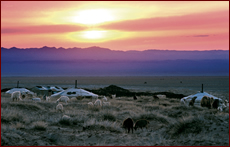
Wild Bactrian camels are under threat because of habitat loss, hunting and competition. Their habitat is decreasing, as more and more towns grow up on the Mongolian desert where they live, cutting down their access to water at drinking holes. Prolonged drought has also reduced the number of watering holes available. The huge numbers of domesticated camels are in direct competition with the wild camels for food, which is already relatively scarce. Unfortunately, the wild camels are also hunted by illegal miners who kill them for food.
Part of the Gobi Desert is a strictly protected area, and provides a largely untouched area for some of the most endangered species of animals to live in. In the protected area there are 410 plant species, 49 mammal species, 15 reptiles and amphibians and over 150 bird species. The world’s only desert-living bear, the Gobi Bear, is only found here and it is thought that there are less than 50 left in the wild.
Travel:
Mongolia has 1,815km of railways, which, for a country of 1.5 million square km, is relatively little. Of its 50,000km of roads, only around 2,500km are paved – the rest are tracks across the desert. As the rail and road links are so sparse, Mongolia relies heavily on air transport. There are over 80 airports but very few of them have paved runways.
Camels are vital for transport and travel across the desert, as they are brilliantly adapted for the conditions. They are able to travel long distances carrying heavy loads; up to 200 kilos at 5km/hr, which is the same speed as a horse but carrying 3 times as much weight. Even now, when many Mongolians have motorised vehicles, camels carry around 30% of cargo across the Gobi desert. Unlike motorbikes or trucks, camels can work unaffected by the extremes of heat and cold in the desert, and they easily negotiate rough, stony ground.
Many nomadic herders now use motorbikes as well as keeping their camels.
While travelling, Mongolians can be sure of a warm welcome whenever they come across another gher in the desert. It is Mongolian custom to welcome any visitor with tea and food, and even if there is no one at home, visitors can enter the gher and make themselves tea without causing offence. Visitors aren’t expected to pay for the hospitality as this would cause offence, but gifts for the children are very welcome.
